Assessment of Homeostasis and Nervous System for Level 3 Biology, 2020
VerifiedAdded on 2023/01/13
|20
|5353
|90
Homework Assignment
AI Summary
This Level 3 biology assignment assesses understanding of homeostasis and the nervous system. Part one involves observing a video on homeostasis in marathon runners, followed by an in-class assessment and a take-home worksheet. Part two focuses on the nervous system, with a take-home worksheet covering its structure, components, and functions. The assignment includes controlled assessment rules, grade descriptors for merit and distinction, and emphasizes the application of knowledge, quality of work, and adherence to word limits and referencing guidelines. Students are expected to explain homeostatic mechanisms, analyze the nervous system's role, and demonstrate understanding of nerve impulse generation and synaptic transmission. The assignment is broken into tasks, and students are to submit their work with a signed learner declaration.
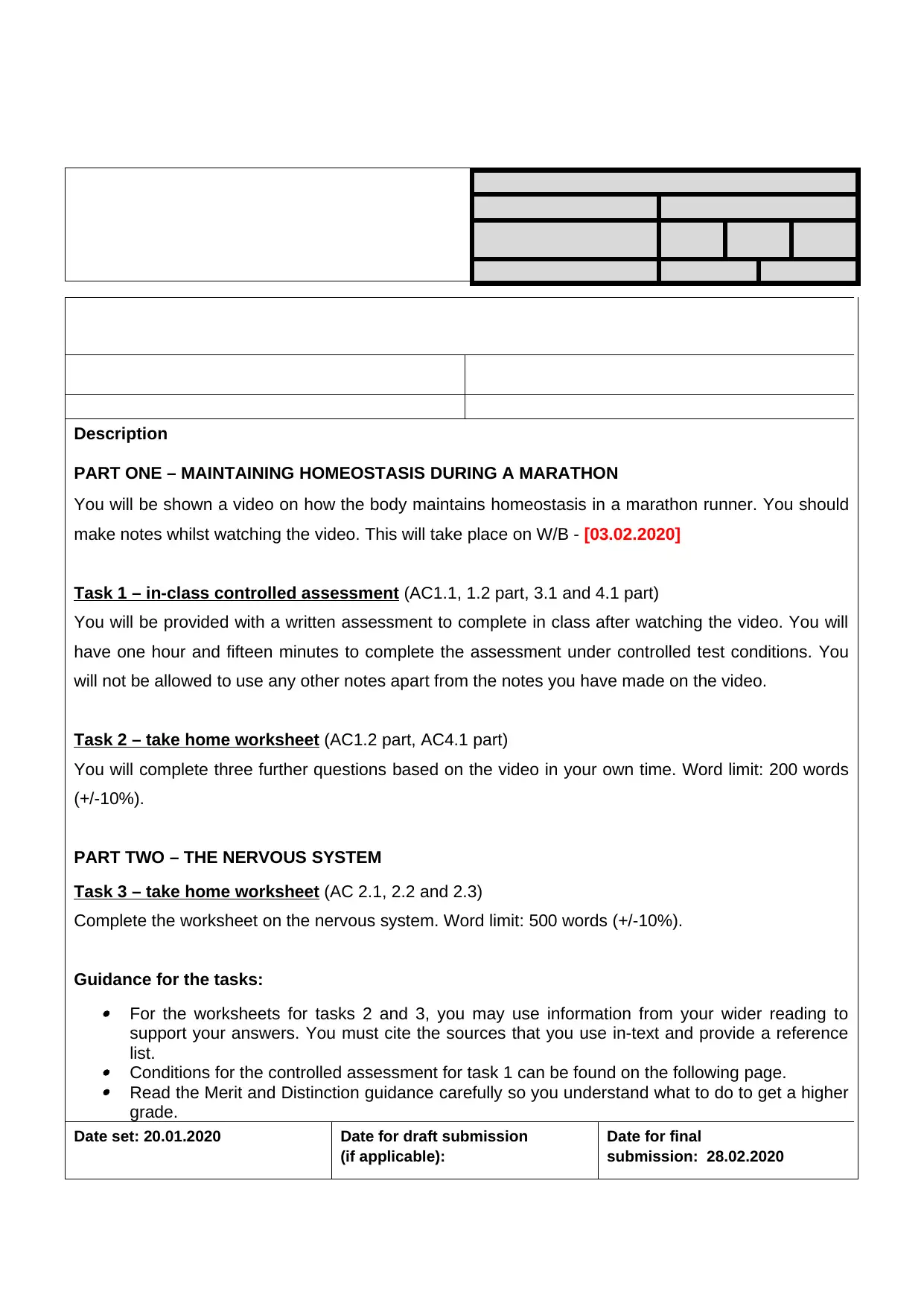
“”
Description
PART ONE – MAINTAINING HOMEOSTASIS DURING A MARATHON
You will be shown a video on how the body maintains homeostasis in a marathon runner. You should
make notes whilst watching the video. This will take place on W/B - [03.02.2020]
Task 1 – in-class controlled assessment (AC1.1, 1.2 part, 3.1 and 4.1 part)
You will be provided with a written assessment to complete in class after watching the video. You will
have one hour and fifteen minutes to complete the assessment under controlled test conditions. You
will not be allowed to use any other notes apart from the notes you have made on the video.
Task 2 – take home worksheet (AC1.2 part, AC4.1 part)
You will complete three further questions based on the video in your own time. Word limit: 200 words
(+/-10%).
PART TWO – THE NERVOUS SYSTEM
Task 3 – take home worksheet (AC 2.1, 2.2 and 2.3)
Complete the worksheet on the nervous system. Word limit: 500 words (+/-10%).
Guidance for the tasks: For the worksheets for tasks 2 and 3, you may use information from your wider reading to
support your answers. You must cite the sources that you use in-text and provide a reference
list. Conditions for the controlled assessment for task 1 can be found on the following page. Read the Merit and Distinction guidance carefully so you understand what to do to get a higher
grade.
Date set: 20.01.2020 Date for draft submission
(if applicable):
Date for final
submission: 28.02.2020
Description
PART ONE – MAINTAINING HOMEOSTASIS DURING A MARATHON
You will be shown a video on how the body maintains homeostasis in a marathon runner. You should
make notes whilst watching the video. This will take place on W/B - [03.02.2020]
Task 1 – in-class controlled assessment (AC1.1, 1.2 part, 3.1 and 4.1 part)
You will be provided with a written assessment to complete in class after watching the video. You will
have one hour and fifteen minutes to complete the assessment under controlled test conditions. You
will not be allowed to use any other notes apart from the notes you have made on the video.
Task 2 – take home worksheet (AC1.2 part, AC4.1 part)
You will complete three further questions based on the video in your own time. Word limit: 200 words
(+/-10%).
PART TWO – THE NERVOUS SYSTEM
Task 3 – take home worksheet (AC 2.1, 2.2 and 2.3)
Complete the worksheet on the nervous system. Word limit: 500 words (+/-10%).
Guidance for the tasks: For the worksheets for tasks 2 and 3, you may use information from your wider reading to
support your answers. You must cite the sources that you use in-text and provide a reference
list. Conditions for the controlled assessment for task 1 can be found on the following page. Read the Merit and Distinction guidance carefully so you understand what to do to get a higher
grade.
Date set: 20.01.2020 Date for draft submission
(if applicable):
Date for final
submission: 28.02.2020
Paraphrase This Document
Need a fresh take? Get an instant paraphrase of this document with our AI Paraphraser

Extension date
(if agreed): Signed by Tutor/Assessor to
agree extension:
Date
submitted:
Internal Moderation: Yes / No
Date:
Signed by internal moderator: ON TIME / LATE
Learner declaration:
The explanations and evaluations in this work have been developed and written by me.
I have not submitted material copied from the Internet, text books or other sources in place of my own thinking
and writing.
When I have referred to the work of others I have done so to discuss, comment on or argue their ideas.
I have kept quotation and paraphrasing to an absolute minimum and only to support points I have made.
I understand that referencing the names of authors whose ideas I have used without including my own
interpretation of those ideas, does not meet the assessment criteria and cannot attract the Pass, Merit or
Distinction grades.
I have not copied the work of my peers.
Learner comments: (please use this space to comment on any aspect of the assignment when handing in your work)
Signature: Date:
TO THE LEARNER: Please attach this assignment brief to any written work you are handing in for assessment, or
submit the brief as instructed.
YOUR WORK CANNOT BE ASSESSED UNLESS YOU HAVE SIGNED AND SUBMITTED THIS FORM
(if agreed): Signed by Tutor/Assessor to
agree extension:
Date
submitted:
Internal Moderation: Yes / No
Date:
Signed by internal moderator: ON TIME / LATE
Learner declaration:
The explanations and evaluations in this work have been developed and written by me.
I have not submitted material copied from the Internet, text books or other sources in place of my own thinking
and writing.
When I have referred to the work of others I have done so to discuss, comment on or argue their ideas.
I have kept quotation and paraphrasing to an absolute minimum and only to support points I have made.
I understand that referencing the names of authors whose ideas I have used without including my own
interpretation of those ideas, does not meet the assessment criteria and cannot attract the Pass, Merit or
Distinction grades.
I have not copied the work of my peers.
Learner comments: (please use this space to comment on any aspect of the assignment when handing in your work)
Signature: Date:
TO THE LEARNER: Please attach this assignment brief to any written work you are handing in for assessment, or
submit the brief as instructed.
YOUR WORK CANNOT BE ASSESSED UNLESS YOU HAVE SIGNED AND SUBMITTED THIS FORM
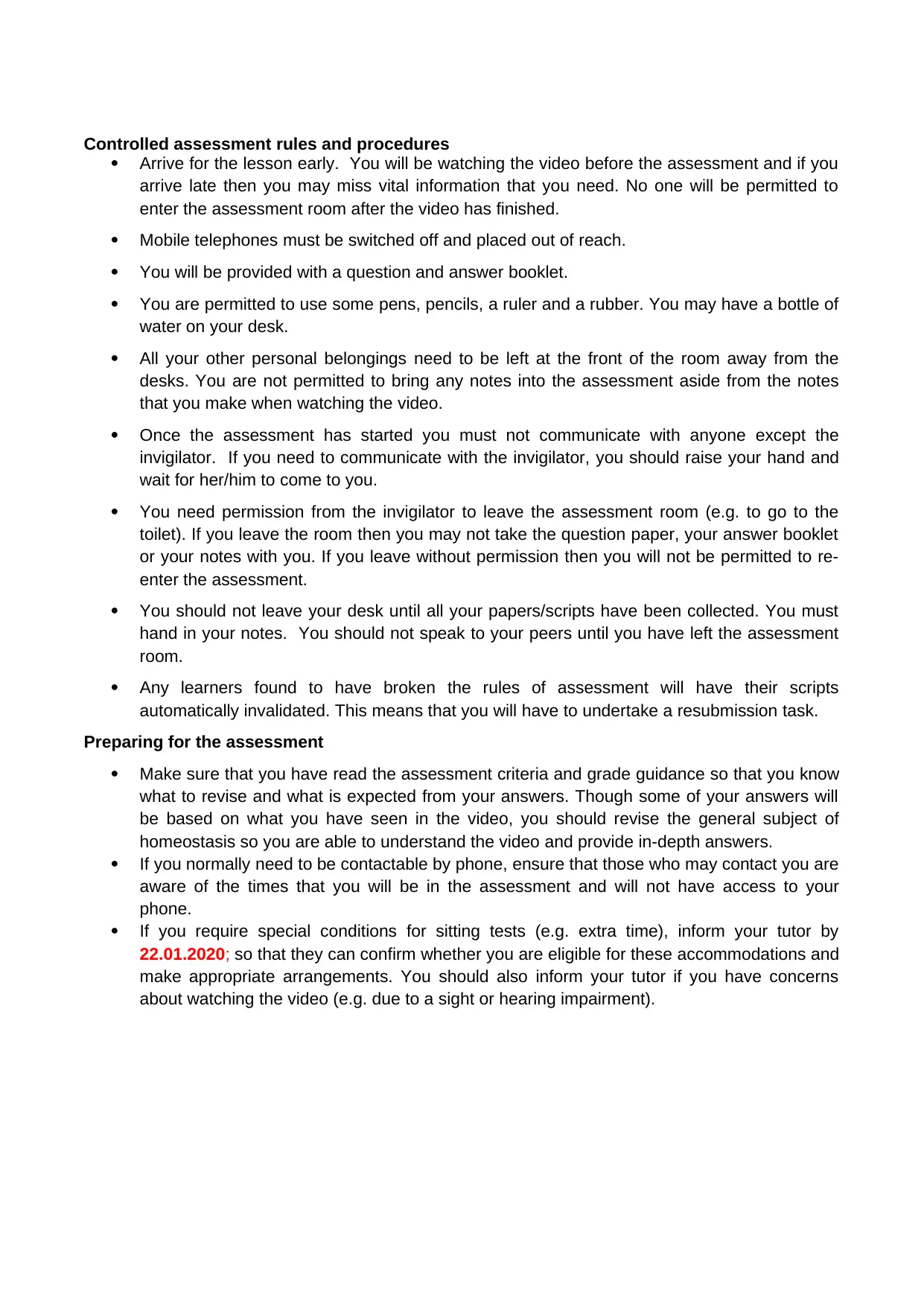
Controlled assessment rules and procedures
Arrive for the lesson early. You will be watching the video before the assessment and if you
arrive late then you may miss vital information that you need. No one will be permitted to
enter the assessment room after the video has finished.
Mobile telephones must be switched off and placed out of reach.
You will be provided with a question and answer booklet.
You are permitted to use some pens, pencils, a ruler and a rubber. You may have a bottle of
water on your desk.
All your other personal belongings need to be left at the front of the room away from the
desks. You are not permitted to bring any notes into the assessment aside from the notes
that you make when watching the video.
Once the assessment has started you must not communicate with anyone except the
invigilator. If you need to communicate with the invigilator, you should raise your hand and
wait for her/him to come to you.
You need permission from the invigilator to leave the assessment room (e.g. to go to the
toilet). If you leave the room then you may not take the question paper, your answer booklet
or your notes with you. If you leave without permission then you will not be permitted to re-
enter the assessment.
You should not leave your desk until all your papers/scripts have been collected. You must
hand in your notes. You should not speak to your peers until you have left the assessment
room.
Any learners found to have broken the rules of assessment will have their scripts
automatically invalidated. This means that you will have to undertake a resubmission task.
Preparing for the assessment
Make sure that you have read the assessment criteria and grade guidance so that you know
what to revise and what is expected from your answers. Though some of your answers will
be based on what you have seen in the video, you should revise the general subject of
homeostasis so you are able to understand the video and provide in-depth answers.
If you normally need to be contactable by phone, ensure that those who may contact you are
aware of the times that you will be in the assessment and will not have access to your
phone.
If you require special conditions for sitting tests (e.g. extra time), inform your tutor by
22.01.2020; so that they can confirm whether you are eligible for these accommodations and
make appropriate arrangements. You should also inform your tutor if you have concerns
about watching the video (e.g. due to a sight or hearing impairment).
Arrive for the lesson early. You will be watching the video before the assessment and if you
arrive late then you may miss vital information that you need. No one will be permitted to
enter the assessment room after the video has finished.
Mobile telephones must be switched off and placed out of reach.
You will be provided with a question and answer booklet.
You are permitted to use some pens, pencils, a ruler and a rubber. You may have a bottle of
water on your desk.
All your other personal belongings need to be left at the front of the room away from the
desks. You are not permitted to bring any notes into the assessment aside from the notes
that you make when watching the video.
Once the assessment has started you must not communicate with anyone except the
invigilator. If you need to communicate with the invigilator, you should raise your hand and
wait for her/him to come to you.
You need permission from the invigilator to leave the assessment room (e.g. to go to the
toilet). If you leave the room then you may not take the question paper, your answer booklet
or your notes with you. If you leave without permission then you will not be permitted to re-
enter the assessment.
You should not leave your desk until all your papers/scripts have been collected. You must
hand in your notes. You should not speak to your peers until you have left the assessment
room.
Any learners found to have broken the rules of assessment will have their scripts
automatically invalidated. This means that you will have to undertake a resubmission task.
Preparing for the assessment
Make sure that you have read the assessment criteria and grade guidance so that you know
what to revise and what is expected from your answers. Though some of your answers will
be based on what you have seen in the video, you should revise the general subject of
homeostasis so you are able to understand the video and provide in-depth answers.
If you normally need to be contactable by phone, ensure that those who may contact you are
aware of the times that you will be in the assessment and will not have access to your
phone.
If you require special conditions for sitting tests (e.g. extra time), inform your tutor by
22.01.2020; so that they can confirm whether you are eligible for these accommodations and
make appropriate arrangements. You should also inform your tutor if you have concerns
about watching the video (e.g. due to a sight or hearing impairment).
⊘ This is a preview!⊘
Do you want full access?
Subscribe today to unlock all pages.

Trusted by 1+ million students worldwide
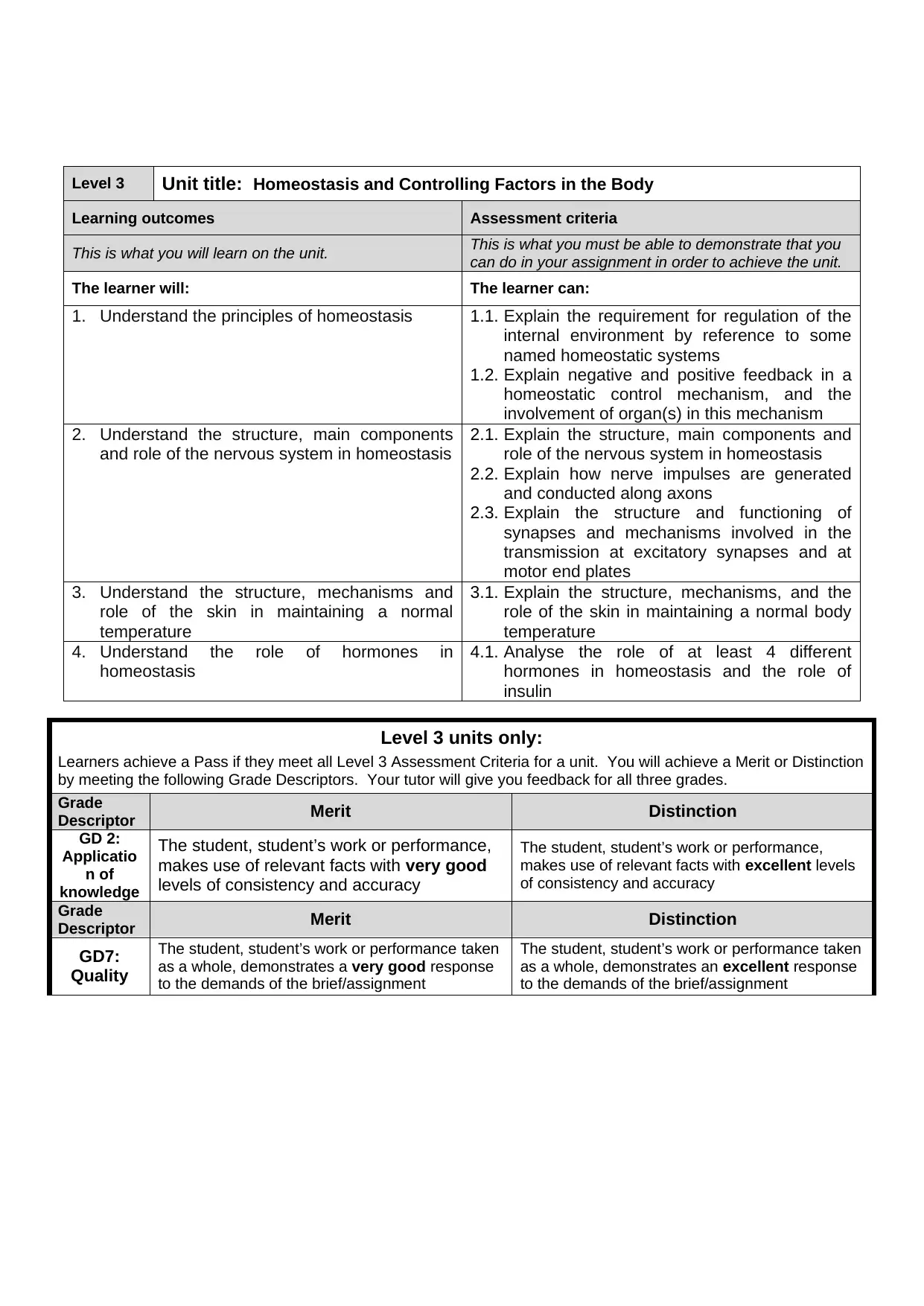
Level 3 Unit title: Homeostasis and Controlling Factors in the Body
Learning outcomes Assessment criteria
This is what you will learn on the unit. This is what you must be able to demonstrate that you
can do in your assignment in order to achieve the unit.
The learner will: The learner can:
1. Understand the principles of homeostasis 1.1. Explain the requirement for regulation of the
internal environment by reference to some
named homeostatic systems
1.2. Explain negative and positive feedback in a
homeostatic control mechanism, and the
involvement of organ(s) in this mechanism
2. Understand the structure, main components
and role of the nervous system in homeostasis
2.1. Explain the structure, main components and
role of the nervous system in homeostasis
2.2. Explain how nerve impulses are generated
and conducted along axons
2.3. Explain the structure and functioning of
synapses and mechanisms involved in the
transmission at excitatory synapses and at
motor end plates
3. Understand the structure, mechanisms and
role of the skin in maintaining a normal
temperature
3.1. Explain the structure, mechanisms, and the
role of the skin in maintaining a normal body
temperature
4. Understand the role of hormones in
homeostasis
4.1. Analyse the role of at least 4 different
hormones in homeostasis and the role of
insulin
Level 3 units only:
Learners achieve a Pass if they meet all Level 3 Assessment Criteria for a unit. You will achieve a Merit or Distinction
by meeting the following Grade Descriptors. Your tutor will give you feedback for all three grades.
Grade
Descriptor Merit Distinction
GD 2:
Applicatio
n of
knowledge
The student, student’s work or performance,
makes use of relevant facts with very good
levels of consistency and accuracy
The student, student’s work or performance,
makes use of relevant facts with excellent levels
of consistency and accuracy
Grade
Descriptor Merit Distinction
GD7:
Quality
The student, student’s work or performance taken
as a whole, demonstrates a very good response
to the demands of the brief/assignment
The student, student’s work or performance taken
as a whole, demonstrates an excellent response
to the demands of the brief/assignment
Learning outcomes Assessment criteria
This is what you will learn on the unit. This is what you must be able to demonstrate that you
can do in your assignment in order to achieve the unit.
The learner will: The learner can:
1. Understand the principles of homeostasis 1.1. Explain the requirement for regulation of the
internal environment by reference to some
named homeostatic systems
1.2. Explain negative and positive feedback in a
homeostatic control mechanism, and the
involvement of organ(s) in this mechanism
2. Understand the structure, main components
and role of the nervous system in homeostasis
2.1. Explain the structure, main components and
role of the nervous system in homeostasis
2.2. Explain how nerve impulses are generated
and conducted along axons
2.3. Explain the structure and functioning of
synapses and mechanisms involved in the
transmission at excitatory synapses and at
motor end plates
3. Understand the structure, mechanisms and
role of the skin in maintaining a normal
temperature
3.1. Explain the structure, mechanisms, and the
role of the skin in maintaining a normal body
temperature
4. Understand the role of hormones in
homeostasis
4.1. Analyse the role of at least 4 different
hormones in homeostasis and the role of
insulin
Level 3 units only:
Learners achieve a Pass if they meet all Level 3 Assessment Criteria for a unit. You will achieve a Merit or Distinction
by meeting the following Grade Descriptors. Your tutor will give you feedback for all three grades.
Grade
Descriptor Merit Distinction
GD 2:
Applicatio
n of
knowledge
The student, student’s work or performance,
makes use of relevant facts with very good
levels of consistency and accuracy
The student, student’s work or performance,
makes use of relevant facts with excellent levels
of consistency and accuracy
Grade
Descriptor Merit Distinction
GD7:
Quality
The student, student’s work or performance taken
as a whole, demonstrates a very good response
to the demands of the brief/assignment
The student, student’s work or performance taken
as a whole, demonstrates an excellent response
to the demands of the brief/assignment
Paraphrase This Document
Need a fresh take? Get an instant paraphrase of this document with our AI Paraphraser

Grade Guidance: Learners must carefully read the guidance below which is linked to the components above
MERIT:
GD 2: Application of knowledge
Tasks 1 and 2
The role of most hormones linked to maintenance of homeostasis will generally be explained. The
hormones chosen should be linked to specific homeostatic mechanisms which should take place in
marathon runner.
For some of the homeostatic approaches chosen you will consider the implications if they cannot
achieve homeostasis.
Your response will be linked to the context of marathon runner and the other contexts/scenarios
provided in most instances and not deviate to general explanations.
Task 3
Your summary diagram of the nervous system will consider all the main components (brain, spinal
cord, neurons and receptors) of the nervous system in some detail and it will generally be related to
its role in maintaining homeostasis and not divert to their general roles. Your explanation should
cover with a general level of accuracy both the Central Nervous System (CNS) and the Peripheral
Nervous System (PNS).
You will be able to apply, with some accuracy, your knowledge of nerve impulse generation,
transmission to explain the effect of multiple sclerosis. Most of the steps of synaptic transmission
are applied to context of depression.
GD7: Quality
Your answers will generally be structured in a logical manner and you will write in sentences
fluently. You will use correct biological terminology most of the time.
In tasks 2 and 3, you will have used a range of sources to support your answers. Your referencing
will generally follow the Harvard System.
You will have kept to the specified word count on most tasks.
If you use images and drawings then these will be clear and labelled and will be integrated into your
response to each task.
Overall, the work will be generally well-organised and well-presented.
MERIT:
GD 2: Application of knowledge
Tasks 1 and 2
The role of most hormones linked to maintenance of homeostasis will generally be explained. The
hormones chosen should be linked to specific homeostatic mechanisms which should take place in
marathon runner.
For some of the homeostatic approaches chosen you will consider the implications if they cannot
achieve homeostasis.
Your response will be linked to the context of marathon runner and the other contexts/scenarios
provided in most instances and not deviate to general explanations.
Task 3
Your summary diagram of the nervous system will consider all the main components (brain, spinal
cord, neurons and receptors) of the nervous system in some detail and it will generally be related to
its role in maintaining homeostasis and not divert to their general roles. Your explanation should
cover with a general level of accuracy both the Central Nervous System (CNS) and the Peripheral
Nervous System (PNS).
You will be able to apply, with some accuracy, your knowledge of nerve impulse generation,
transmission to explain the effect of multiple sclerosis. Most of the steps of synaptic transmission
are applied to context of depression.
GD7: Quality
Your answers will generally be structured in a logical manner and you will write in sentences
fluently. You will use correct biological terminology most of the time.
In tasks 2 and 3, you will have used a range of sources to support your answers. Your referencing
will generally follow the Harvard System.
You will have kept to the specified word count on most tasks.
If you use images and drawings then these will be clear and labelled and will be integrated into your
response to each task.
Overall, the work will be generally well-organised and well-presented.
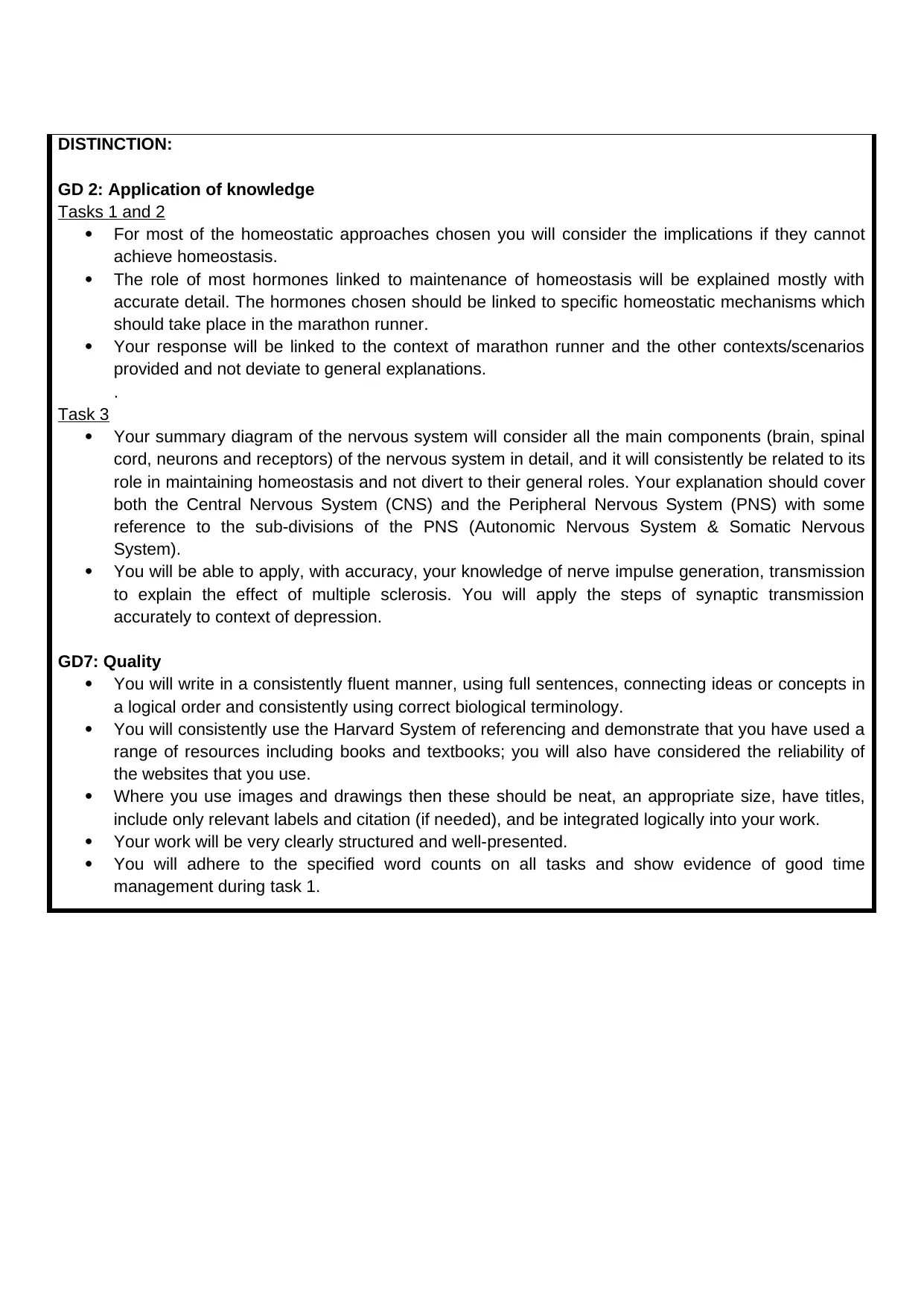
DISTINCTION:
GD 2: Application of knowledge
Tasks 1 and 2
For most of the homeostatic approaches chosen you will consider the implications if they cannot
achieve homeostasis.
The role of most hormones linked to maintenance of homeostasis will be explained mostly with
accurate detail. The hormones chosen should be linked to specific homeostatic mechanisms which
should take place in the marathon runner.
Your response will be linked to the context of marathon runner and the other contexts/scenarios
provided and not deviate to general explanations.
.
Task 3
Your summary diagram of the nervous system will consider all the main components (brain, spinal
cord, neurons and receptors) of the nervous system in detail, and it will consistently be related to its
role in maintaining homeostasis and not divert to their general roles. Your explanation should cover
both the Central Nervous System (CNS) and the Peripheral Nervous System (PNS) with some
reference to the sub-divisions of the PNS (Autonomic Nervous System & Somatic Nervous
System).
You will be able to apply, with accuracy, your knowledge of nerve impulse generation, transmission
to explain the effect of multiple sclerosis. You will apply the steps of synaptic transmission
accurately to context of depression.
GD7: Quality
You will write in a consistently fluent manner, using full sentences, connecting ideas or concepts in
a logical order and consistently using correct biological terminology.
You will consistently use the Harvard System of referencing and demonstrate that you have used a
range of resources including books and textbooks; you will also have considered the reliability of
the websites that you use.
Where you use images and drawings then these should be neat, an appropriate size, have titles,
include only relevant labels and citation (if needed), and be integrated logically into your work.
Your work will be very clearly structured and well-presented.
You will adhere to the specified word counts on all tasks and show evidence of good time
management during task 1.
GD 2: Application of knowledge
Tasks 1 and 2
For most of the homeostatic approaches chosen you will consider the implications if they cannot
achieve homeostasis.
The role of most hormones linked to maintenance of homeostasis will be explained mostly with
accurate detail. The hormones chosen should be linked to specific homeostatic mechanisms which
should take place in the marathon runner.
Your response will be linked to the context of marathon runner and the other contexts/scenarios
provided and not deviate to general explanations.
.
Task 3
Your summary diagram of the nervous system will consider all the main components (brain, spinal
cord, neurons and receptors) of the nervous system in detail, and it will consistently be related to its
role in maintaining homeostasis and not divert to their general roles. Your explanation should cover
both the Central Nervous System (CNS) and the Peripheral Nervous System (PNS) with some
reference to the sub-divisions of the PNS (Autonomic Nervous System & Somatic Nervous
System).
You will be able to apply, with accuracy, your knowledge of nerve impulse generation, transmission
to explain the effect of multiple sclerosis. You will apply the steps of synaptic transmission
accurately to context of depression.
GD7: Quality
You will write in a consistently fluent manner, using full sentences, connecting ideas or concepts in
a logical order and consistently using correct biological terminology.
You will consistently use the Harvard System of referencing and demonstrate that you have used a
range of resources including books and textbooks; you will also have considered the reliability of
the websites that you use.
Where you use images and drawings then these should be neat, an appropriate size, have titles,
include only relevant labels and citation (if needed), and be integrated logically into your work.
Your work will be very clearly structured and well-presented.
You will adhere to the specified word counts on all tasks and show evidence of good time
management during task 1.
⊘ This is a preview!⊘
Do you want full access?
Subscribe today to unlock all pages.

Trusted by 1+ million students worldwide

Part A: Feedback on credit level
AC no
Credit
achieved
(L3)
Location of
evidence
Tutor/Assessor comments on assessment criteria
(the assessor may also indicate on the work itself where each AC is met)
1.1 Task 1
1.2 Task 1
Task 2
2.1 Task 3
2.2 Task 3
2.3 Task 3
3.1 Task 1
4.1 Task 1
Task 2
Level achieved Tutor/Assessor’s
signature: Date:
AC no
Credit
achieved
(L3)
Location of
evidence
Tutor/Assessor comments on assessment criteria
(the assessor may also indicate on the work itself where each AC is met)
1.1 Task 1
1.2 Task 1
Task 2
2.1 Task 3
2.2 Task 3
2.3 Task 3
3.1 Task 1
4.1 Task 1
Task 2
Level achieved Tutor/Assessor’s
signature: Date:
Paraphrase This Document
Need a fresh take? Get an instant paraphrase of this document with our AI Paraphraser
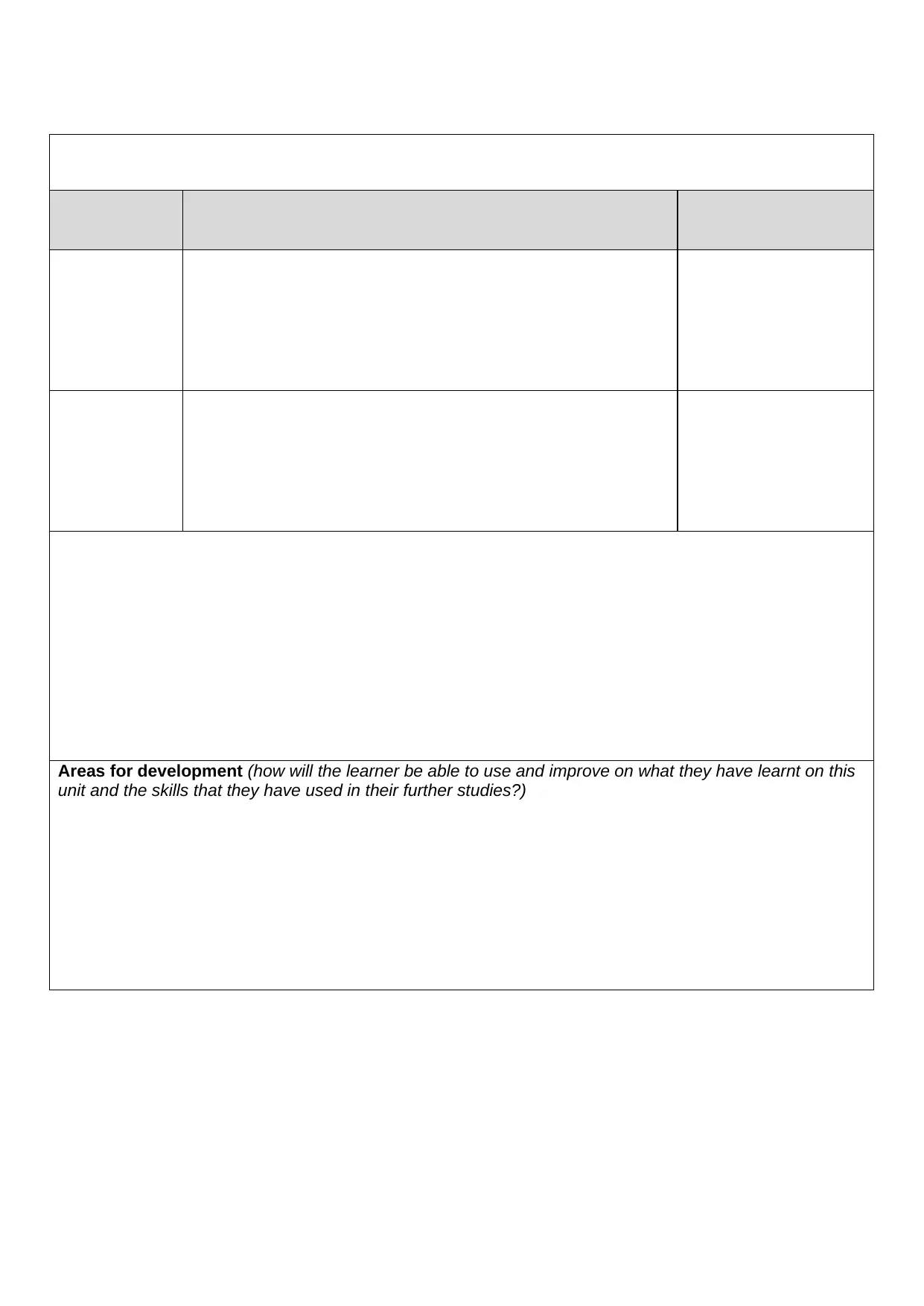
Areas for development (how will the learner be able to use and improve on what they have learnt on this
unit and the skills that they have used in their further studies?)
“”
unit and the skills that they have used in their further studies?)
“”
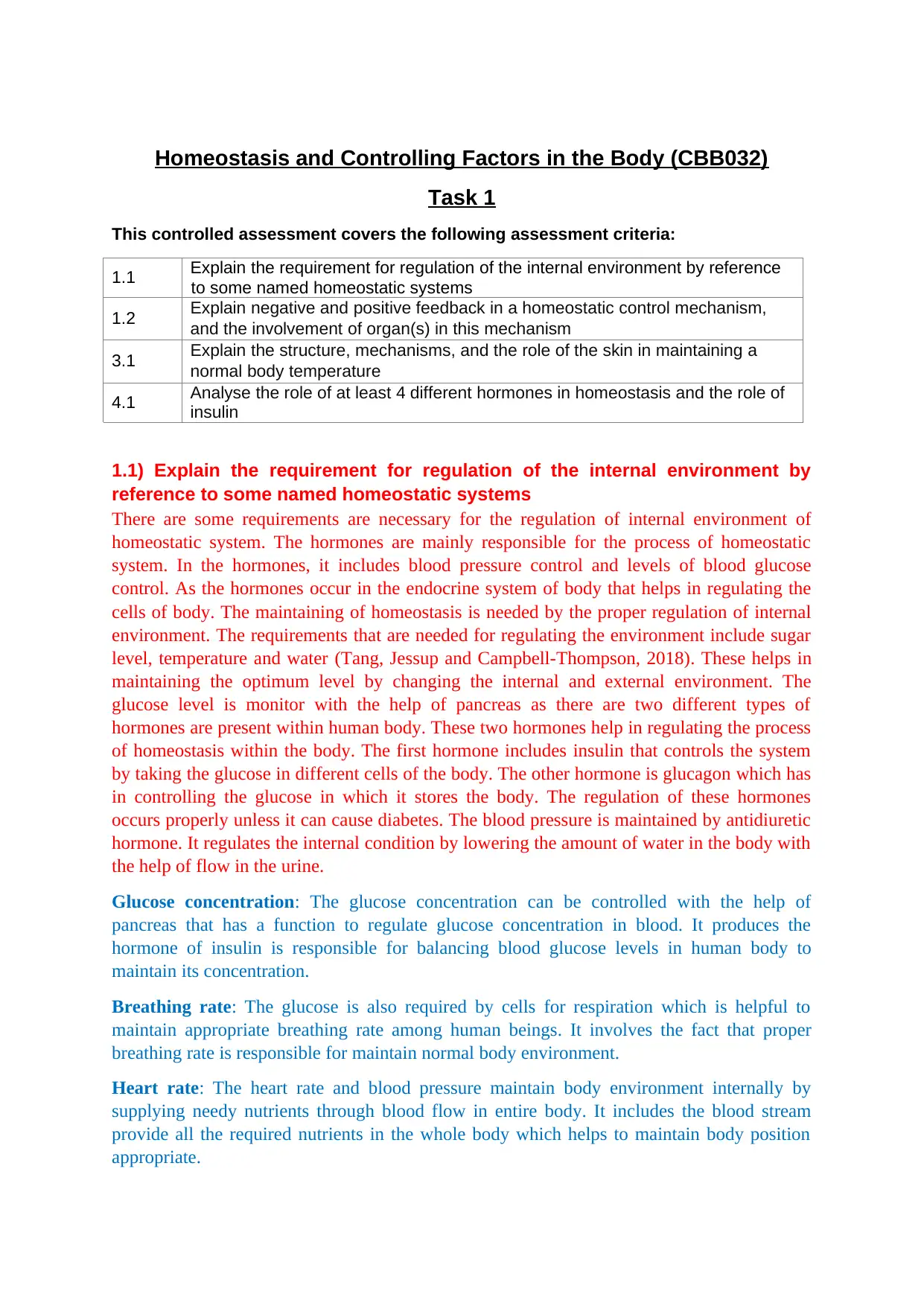
Homeostasis and Controlling Factors in the Body (CBB032)
Task 1
This controlled assessment covers the following assessment criteria:
1.1 Explain the requirement for regulation of the internal environment by reference
to some named homeostatic systems
1.2 Explain negative and positive feedback in a homeostatic control mechanism,
and the involvement of organ(s) in this mechanism
3.1 Explain the structure, mechanisms, and the role of the skin in maintaining a
normal body temperature
4.1 Analyse the role of at least 4 different hormones in homeostasis and the role of
insulin
1.1) Explain the requirement for regulation of the internal environment by
reference to some named homeostatic systems
There are some requirements are necessary for the regulation of internal environment of
homeostatic system. The hormones are mainly responsible for the process of homeostatic
system. In the hormones, it includes blood pressure control and levels of blood glucose
control. As the hormones occur in the endocrine system of body that helps in regulating the
cells of body. The maintaining of homeostasis is needed by the proper regulation of internal
environment. The requirements that are needed for regulating the environment include sugar
level, temperature and water (Tang, Jessup and Campbell-Thompson, 2018). These helps in
maintaining the optimum level by changing the internal and external environment. The
glucose level is monitor with the help of pancreas as there are two different types of
hormones are present within human body. These two hormones help in regulating the process
of homeostasis within the body. The first hormone includes insulin that controls the system
by taking the glucose in different cells of the body. The other hormone is glucagon which has
in controlling the glucose in which it stores the body. The regulation of these hormones
occurs properly unless it can cause diabetes. The blood pressure is maintained by antidiuretic
hormone. It regulates the internal condition by lowering the amount of water in the body with
the help of flow in the urine.
Glucose concentration: The glucose concentration can be controlled with the help of
pancreas that has a function to regulate glucose concentration in blood. It produces the
hormone of insulin is responsible for balancing blood glucose levels in human body to
maintain its concentration.
Breathing rate: The glucose is also required by cells for respiration which is helpful to
maintain appropriate breathing rate among human beings. It involves the fact that proper
breathing rate is responsible for maintain normal body environment.
Heart rate: The heart rate and blood pressure maintain body environment internally by
supplying needy nutrients through blood flow in entire body. It includes the blood stream
provide all the required nutrients in the whole body which helps to maintain body position
appropriate.
Task 1
This controlled assessment covers the following assessment criteria:
1.1 Explain the requirement for regulation of the internal environment by reference
to some named homeostatic systems
1.2 Explain negative and positive feedback in a homeostatic control mechanism,
and the involvement of organ(s) in this mechanism
3.1 Explain the structure, mechanisms, and the role of the skin in maintaining a
normal body temperature
4.1 Analyse the role of at least 4 different hormones in homeostasis and the role of
insulin
1.1) Explain the requirement for regulation of the internal environment by
reference to some named homeostatic systems
There are some requirements are necessary for the regulation of internal environment of
homeostatic system. The hormones are mainly responsible for the process of homeostatic
system. In the hormones, it includes blood pressure control and levels of blood glucose
control. As the hormones occur in the endocrine system of body that helps in regulating the
cells of body. The maintaining of homeostasis is needed by the proper regulation of internal
environment. The requirements that are needed for regulating the environment include sugar
level, temperature and water (Tang, Jessup and Campbell-Thompson, 2018). These helps in
maintaining the optimum level by changing the internal and external environment. The
glucose level is monitor with the help of pancreas as there are two different types of
hormones are present within human body. These two hormones help in regulating the process
of homeostasis within the body. The first hormone includes insulin that controls the system
by taking the glucose in different cells of the body. The other hormone is glucagon which has
in controlling the glucose in which it stores the body. The regulation of these hormones
occurs properly unless it can cause diabetes. The blood pressure is maintained by antidiuretic
hormone. It regulates the internal condition by lowering the amount of water in the body with
the help of flow in the urine.
Glucose concentration: The glucose concentration can be controlled with the help of
pancreas that has a function to regulate glucose concentration in blood. It produces the
hormone of insulin is responsible for balancing blood glucose levels in human body to
maintain its concentration.
Breathing rate: The glucose is also required by cells for respiration which is helpful to
maintain appropriate breathing rate among human beings. It involves the fact that proper
breathing rate is responsible for maintain normal body environment.
Heart rate: The heart rate and blood pressure maintain body environment internally by
supplying needy nutrients through blood flow in entire body. It includes the blood stream
provide all the required nutrients in the whole body which helps to maintain body position
appropriate.
⊘ This is a preview!⊘
Do you want full access?
Subscribe today to unlock all pages.

Trusted by 1+ million students worldwide
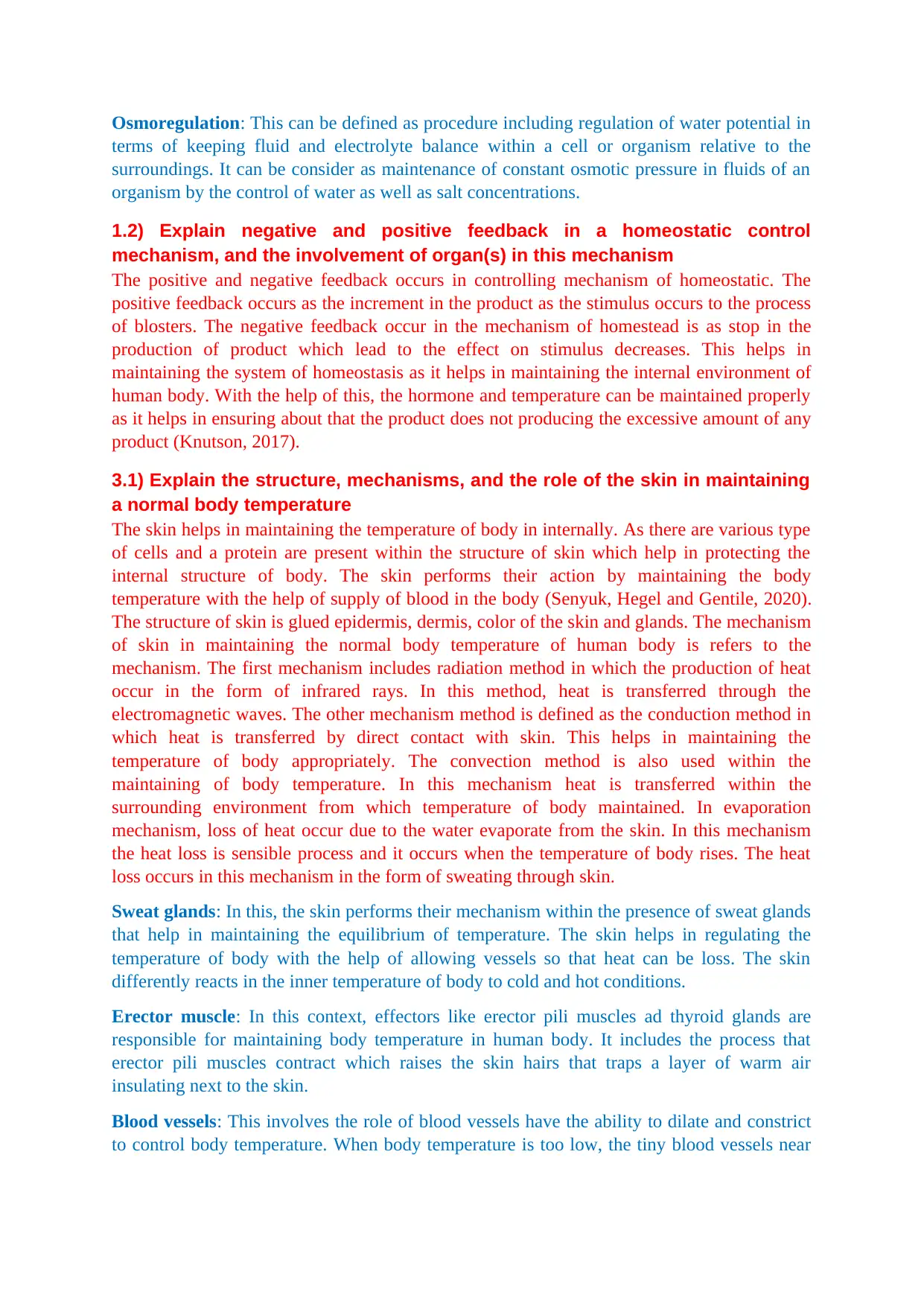
Osmoregulation: This can be defined as procedure including regulation of water potential in
terms of keeping fluid and electrolyte balance within a cell or organism relative to the
surroundings. It can be consider as maintenance of constant osmotic pressure in fluids of an
organism by the control of water as well as salt concentrations.
1.2) Explain negative and positive feedback in a homeostatic control
mechanism, and the involvement of organ(s) in this mechanism
The positive and negative feedback occurs in controlling mechanism of homeostatic. The
positive feedback occurs as the increment in the product as the stimulus occurs to the process
of blosters. The negative feedback occur in the mechanism of homestead is as stop in the
production of product which lead to the effect on stimulus decreases. This helps in
maintaining the system of homeostasis as it helps in maintaining the internal environment of
human body. With the help of this, the hormone and temperature can be maintained properly
as it helps in ensuring about that the product does not producing the excessive amount of any
product (Knutson, 2017).
3.1) Explain the structure, mechanisms, and the role of the skin in maintaining
a normal body temperature
The skin helps in maintaining the temperature of body in internally. As there are various type
of cells and a protein are present within the structure of skin which help in protecting the
internal structure of body. The skin performs their action by maintaining the body
temperature with the help of supply of blood in the body (Senyuk, Hegel and Gentile, 2020).
The structure of skin is glued epidermis, dermis, color of the skin and glands. The mechanism
of skin in maintaining the normal body temperature of human body is refers to the
mechanism. The first mechanism includes radiation method in which the production of heat
occur in the form of infrared rays. In this method, heat is transferred through the
electromagnetic waves. The other mechanism method is defined as the conduction method in
which heat is transferred by direct contact with skin. This helps in maintaining the
temperature of body appropriately. The convection method is also used within the
maintaining of body temperature. In this mechanism heat is transferred within the
surrounding environment from which temperature of body maintained. In evaporation
mechanism, loss of heat occur due to the water evaporate from the skin. In this mechanism
the heat loss is sensible process and it occurs when the temperature of body rises. The heat
loss occurs in this mechanism in the form of sweating through skin.
Sweat glands: In this, the skin performs their mechanism within the presence of sweat glands
that help in maintaining the equilibrium of temperature. The skin helps in regulating the
temperature of body with the help of allowing vessels so that heat can be loss. The skin
differently reacts in the inner temperature of body to cold and hot conditions.
Erector muscle: In this context, effectors like erector pili muscles ad thyroid glands are
responsible for maintaining body temperature in human body. It includes the process that
erector pili muscles contract which raises the skin hairs that traps a layer of warm air
insulating next to the skin.
Blood vessels: This involves the role of blood vessels have the ability to dilate and constrict
to control body temperature. When body temperature is too low, the tiny blood vessels near
terms of keeping fluid and electrolyte balance within a cell or organism relative to the
surroundings. It can be consider as maintenance of constant osmotic pressure in fluids of an
organism by the control of water as well as salt concentrations.
1.2) Explain negative and positive feedback in a homeostatic control
mechanism, and the involvement of organ(s) in this mechanism
The positive and negative feedback occurs in controlling mechanism of homeostatic. The
positive feedback occurs as the increment in the product as the stimulus occurs to the process
of blosters. The negative feedback occur in the mechanism of homestead is as stop in the
production of product which lead to the effect on stimulus decreases. This helps in
maintaining the system of homeostasis as it helps in maintaining the internal environment of
human body. With the help of this, the hormone and temperature can be maintained properly
as it helps in ensuring about that the product does not producing the excessive amount of any
product (Knutson, 2017).
3.1) Explain the structure, mechanisms, and the role of the skin in maintaining
a normal body temperature
The skin helps in maintaining the temperature of body in internally. As there are various type
of cells and a protein are present within the structure of skin which help in protecting the
internal structure of body. The skin performs their action by maintaining the body
temperature with the help of supply of blood in the body (Senyuk, Hegel and Gentile, 2020).
The structure of skin is glued epidermis, dermis, color of the skin and glands. The mechanism
of skin in maintaining the normal body temperature of human body is refers to the
mechanism. The first mechanism includes radiation method in which the production of heat
occur in the form of infrared rays. In this method, heat is transferred through the
electromagnetic waves. The other mechanism method is defined as the conduction method in
which heat is transferred by direct contact with skin. This helps in maintaining the
temperature of body appropriately. The convection method is also used within the
maintaining of body temperature. In this mechanism heat is transferred within the
surrounding environment from which temperature of body maintained. In evaporation
mechanism, loss of heat occur due to the water evaporate from the skin. In this mechanism
the heat loss is sensible process and it occurs when the temperature of body rises. The heat
loss occurs in this mechanism in the form of sweating through skin.
Sweat glands: In this, the skin performs their mechanism within the presence of sweat glands
that help in maintaining the equilibrium of temperature. The skin helps in regulating the
temperature of body with the help of allowing vessels so that heat can be loss. The skin
differently reacts in the inner temperature of body to cold and hot conditions.
Erector muscle: In this context, effectors like erector pili muscles ad thyroid glands are
responsible for maintaining body temperature in human body. It includes the process that
erector pili muscles contract which raises the skin hairs that traps a layer of warm air
insulating next to the skin.
Blood vessels: This involves the role of blood vessels have the ability to dilate and constrict
to control body temperature. When body temperature is too low, the tiny blood vessels near
Paraphrase This Document
Need a fresh take? Get an instant paraphrase of this document with our AI Paraphraser
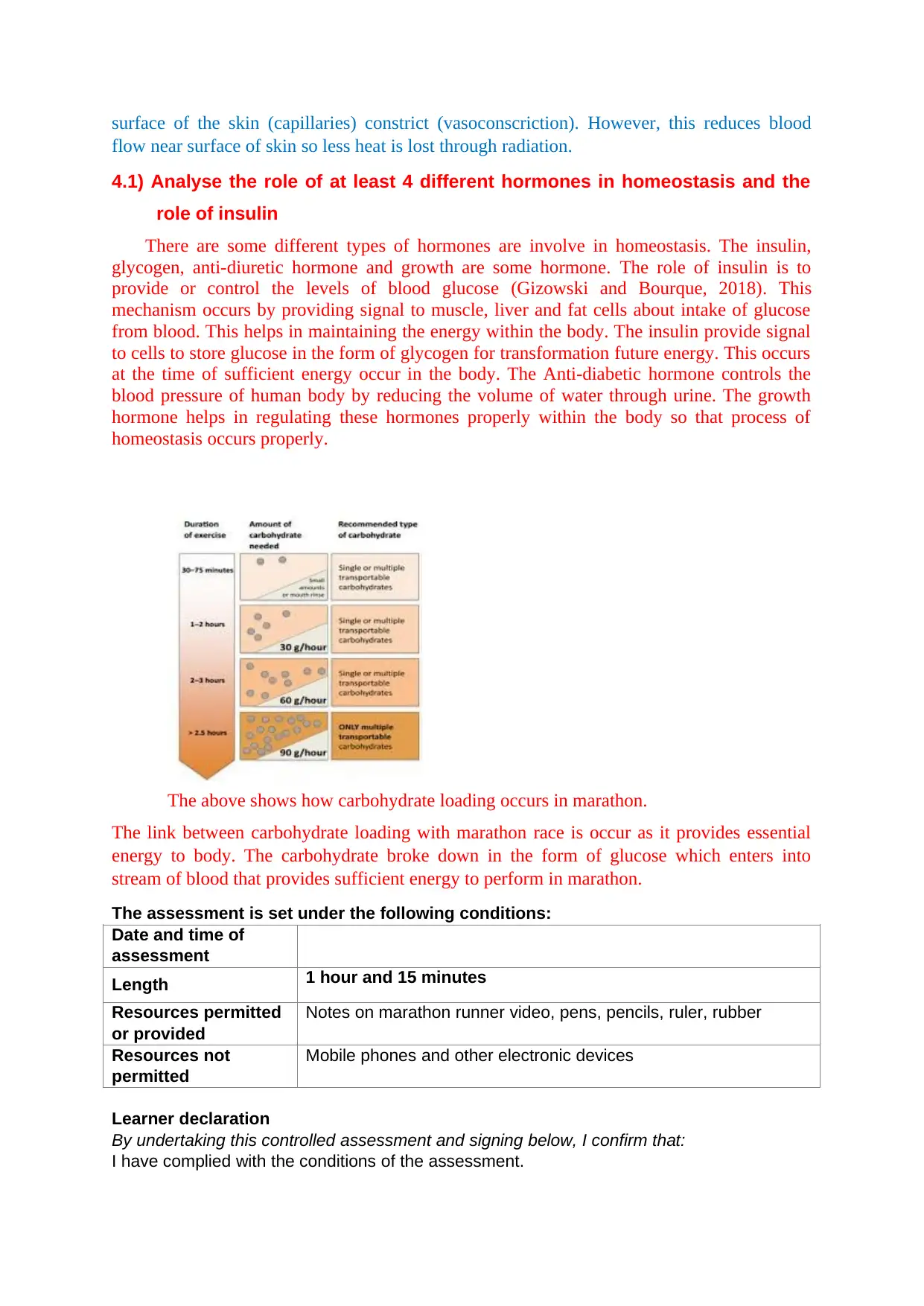
surface of the skin (capillaries) constrict (vasoconscriction). However, this reduces blood
flow near surface of skin so less heat is lost through radiation.
4.1) Analyse the role of at least 4 different hormones in homeostasis and the
role of insulin
There are some different types of hormones are involve in homeostasis. The insulin,
glycogen, anti-diuretic hormone and growth are some hormone. The role of insulin is to
provide or control the levels of blood glucose (Gizowski and Bourque, 2018). This
mechanism occurs by providing signal to muscle, liver and fat cells about intake of glucose
from blood. This helps in maintaining the energy within the body. The insulin provide signal
to cells to store glucose in the form of glycogen for transformation future energy. This occurs
at the time of sufficient energy occur in the body. The Anti-diabetic hormone controls the
blood pressure of human body by reducing the volume of water through urine. The growth
hormone helps in regulating these hormones properly within the body so that process of
homeostasis occurs properly.
The above shows how carbohydrate loading occurs in marathon.
The link between carbohydrate loading with marathon race is occur as it provides essential
energy to body. The carbohydrate broke down in the form of glucose which enters into
stream of blood that provides sufficient energy to perform in marathon.
The assessment is set under the following conditions:
Date and time of
assessment
Length 1 hour and 15 minutes
Resources permitted
or provided
Notes on marathon runner video, pens, pencils, ruler, rubber
Resources not
permitted
Mobile phones and other electronic devices
Learner declaration
By undertaking this controlled assessment and signing below, I confirm that:
I have complied with the conditions of the assessment.
flow near surface of skin so less heat is lost through radiation.
4.1) Analyse the role of at least 4 different hormones in homeostasis and the
role of insulin
There are some different types of hormones are involve in homeostasis. The insulin,
glycogen, anti-diuretic hormone and growth are some hormone. The role of insulin is to
provide or control the levels of blood glucose (Gizowski and Bourque, 2018). This
mechanism occurs by providing signal to muscle, liver and fat cells about intake of glucose
from blood. This helps in maintaining the energy within the body. The insulin provide signal
to cells to store glucose in the form of glycogen for transformation future energy. This occurs
at the time of sufficient energy occur in the body. The Anti-diabetic hormone controls the
blood pressure of human body by reducing the volume of water through urine. The growth
hormone helps in regulating these hormones properly within the body so that process of
homeostasis occurs properly.
The above shows how carbohydrate loading occurs in marathon.
The link between carbohydrate loading with marathon race is occur as it provides essential
energy to body. The carbohydrate broke down in the form of glucose which enters into
stream of blood that provides sufficient energy to perform in marathon.
The assessment is set under the following conditions:
Date and time of
assessment
Length 1 hour and 15 minutes
Resources permitted
or provided
Notes on marathon runner video, pens, pencils, ruler, rubber
Resources not
permitted
Mobile phones and other electronic devices
Learner declaration
By undertaking this controlled assessment and signing below, I confirm that:
I have complied with the conditions of the assessment.

I have not brought into the assessment any materials that would assist me in answering the
exam, unless permitted under the conditions of the assessment.
I will not remove the paper from the assessment room at any point.
I will not have access to my mobile phone or other electronic device during the assessment.
I have not copied the work of my peers.
Learner name:
Signed by learner:
Date:
Allowances: (to be
completed by tutor if any
deviations from the stated
conditions were permitted).
exam, unless permitted under the conditions of the assessment.
I will not remove the paper from the assessment room at any point.
I will not have access to my mobile phone or other electronic device during the assessment.
I have not copied the work of my peers.
Learner name:
Signed by learner:
Date:
Allowances: (to be
completed by tutor if any
deviations from the stated
conditions were permitted).
⊘ This is a preview!⊘
Do you want full access?
Subscribe today to unlock all pages.

Trusted by 1+ million students worldwide
1 out of 20
Related Documents
Your All-in-One AI-Powered Toolkit for Academic Success.
+13062052269
info@desklib.com
Available 24*7 on WhatsApp / Email
![[object Object]](/_next/static/media/star-bottom.7253800d.svg)
Unlock your academic potential
Copyright © 2020–2025 A2Z Services. All Rights Reserved. Developed and managed by ZUCOL.




